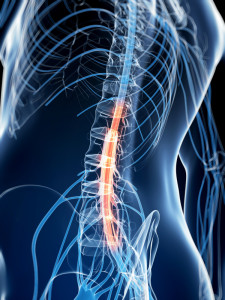Spinal Stenosis Overview
 Spinal stenosis is the narrowing of one or more areas in the spine — most often in the upper or lower back. The narrowing causes strain on the spinal cord or on the nerves that branch out from the compressed areas. Spinal stenosis causes cramping, pain or numbness in a patient’s legs, back, neck, shoulders or arms; loss of sensation in extremities; and can in some cases cause difficulties with bladder or bowel function. In most cases, Spinal stenosis is caused by osteoarthritis-related bone damage. Mild symptoms of spinal stenosis are often helped by pain relievers, physical therapy or a supportive brace. Only in the most serious cases of spinal stenosis do Physicians recommend surgical procedures. Stenosis can develop as a person ages, and is most commonly reported in patients over the age of 50. It can also be a genetic condition.
Spinal stenosis is the narrowing of one or more areas in the spine — most often in the upper or lower back. The narrowing causes strain on the spinal cord or on the nerves that branch out from the compressed areas. Spinal stenosis causes cramping, pain or numbness in a patient’s legs, back, neck, shoulders or arms; loss of sensation in extremities; and can in some cases cause difficulties with bladder or bowel function. In most cases, Spinal stenosis is caused by osteoarthritis-related bone damage. Mild symptoms of spinal stenosis are often helped by pain relievers, physical therapy or a supportive brace. Only in the most serious cases of spinal stenosis do Physicians recommend surgical procedures. Stenosis can develop as a person ages, and is most commonly reported in patients over the age of 50. It can also be a genetic condition.
Spinal Stenosis Symptoms
The narrowing of the spine or areas of the spine doesn’t always cause problems for patients. It is only when the narrowing compresses the spinal column or spinal nerves that a person usually starts to experience the signs and symptoms of Spinal stenosis. The symptoms tend to grow more intense, and worse as time progresses. Some of the most commonly reported symptoms are:
- Pain or cramping in the legs. The compression of the nerves in the lower back lead to pseudoclaudication, false claudication or neurogenic intermittent claudication. This condition most often brings on pain and cramping to the legs when a person either stands for an extended amount of time, or when walking or exercising.
- Radiating back and hip pain. The compression caused by the narrowing of the spine leads to pain that usually starts in the hip or buttocks and continues down the back of the leg. This pain is usually worse when a person is sitting down and most likely only will affect one side.
- Numbness, weakness, or tingling in the legs or feet.
- Neck Pain and/or shoulder pain. When the nerves located in the neck (also referred to as the cervical spine) become compressed, a patient can experience pain in the neck and shoulders. However, the pain may be infrequent, it can be chronic in many cases, and also may extend into the arms and hands.
- Balance problems / loss of balance. The pressure Stenosis puts on the spinal cord may affect the nerves that control balance.
- Loss of bowel or bladder function. In some cases the bladder or bowel may be affected by Stenosis. This usually only occurs in the most severe of cases.
Spinal Stenosis Diagnosis and Treatment
The providers at Michigan Spine & Pain use a variety of methods to diagnose a patient with spinal stenosis, such as medical history, a complete physical exam, x-rays, MRI, CT scan, electrodiagnostics, bone scans , discography and many other methods. Many patients that are diagnosed with spinal stenosis are effectively treated with traditional methods. At Michigan Spine & Pain, we use the following treatment methods to develop a treatment plan specific to each patient’s needs and condition:
- Physical Therapy. Working with a physical therapist can help build strength and endurance in order to maintain the flexibility and stability of your spine.
- Acupuncture. An acupuncture program can help a patient manage their pain in many cases. Acupuncture is a health science that can be used successfully to treat pain and dysfunction in the body. Acupuncture’s goal is to restore normalcy to the body’s energy balance by utilizing a combination of Acupoints located on the twelve meridians. This can be accomplished by a variety of means, the needle is just one.
- Injections. The epidural space is located between the spine and vertebrae. Medication such as corticsoteriod or local anesthetic is injected into this space by way of a needle. It can block the inflammatory chemicals that sensitize nerves and nerve receptors, and thus in many cases – help to reduce pain.
- Chiropractic Care. Chiropractic care is an important part of our treatment plans at Michigan Spine and Pain. Our medical doctors recognize the benefits of chiropractic care, and work with our chiropractor to reduce pain and improve function quickly.
- Massage Therapy. During a massage, a trained, clinical massage practitioner manipulates muscles in the body. This, combined with a full pain management treatment plan, can provide relief. It is a safe procedure that is only performed by one of Michigan Spine & Pains licensed massage therapists.
- Pain Management. Pain Management is an overall approach and philosophy to treating chronic pain conditions. Medications can be an important part of this approach. All of the physicians at Michigan Spine and Pain are Board Certified and have years of experience with acute and chronic pain conditions.
- Pain Psychology. Pain Psychology/Social Work is integral to our treatment plans. Pain is something our patients experience 24 hours a day, seven days a week. This constant battle is depressing and debilitating. Patients and their families may also have lost income or relationships due to injury or illness. At Michigan Spine and Pain we believe it is important to address these issues along with the physical issues.
- Transcutaneous Electrical Nerve Stimulation (TENS). Electrodes placed the skin near the painful areas deliver tiny electrical impulses that may relieve pain
